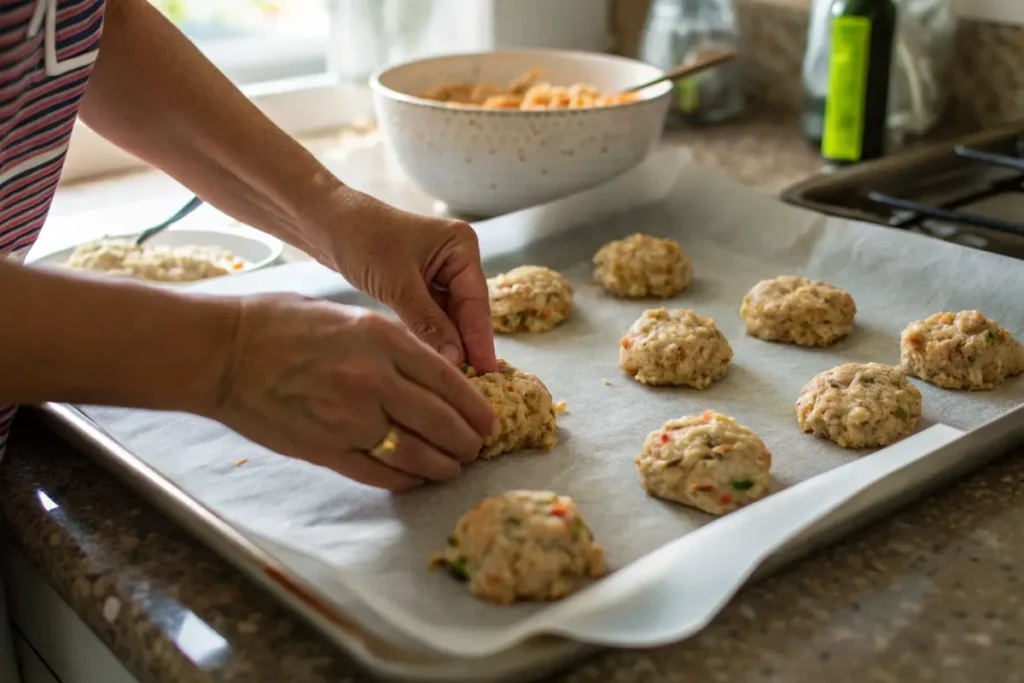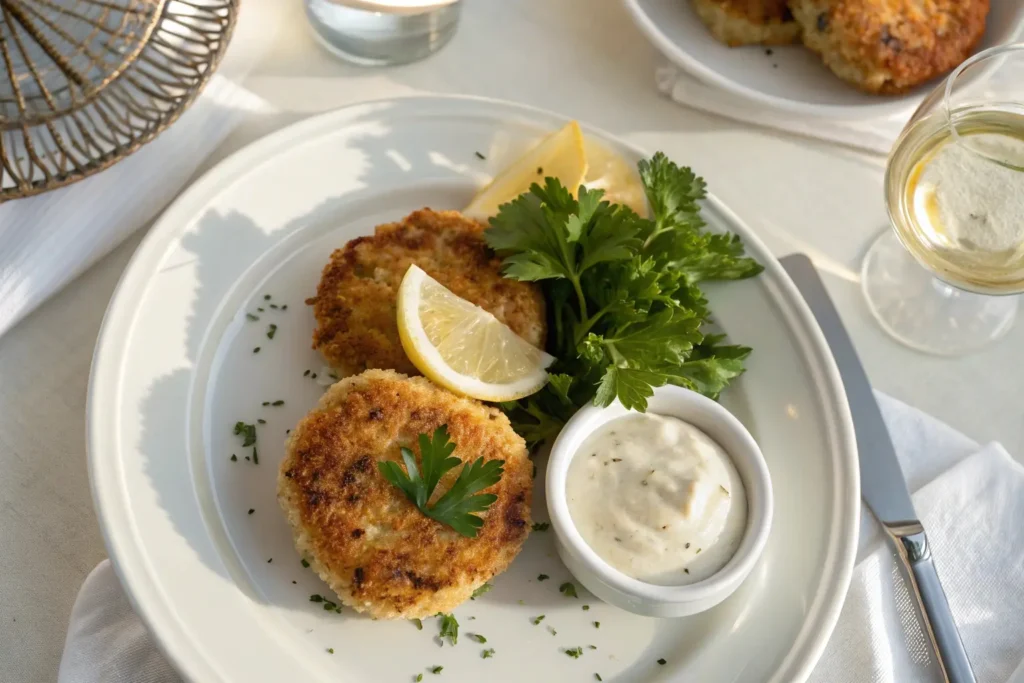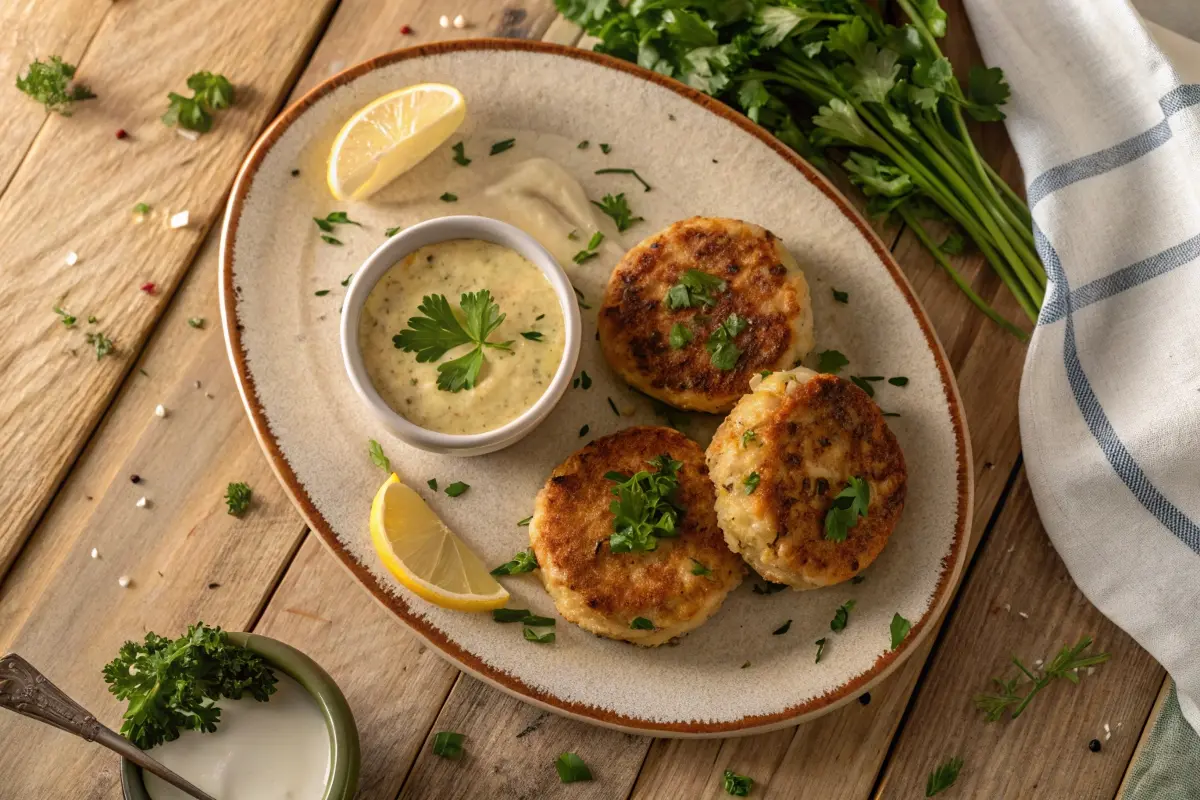Crab cakes are more than just a meal—they’re a taste of tradition, especially when it comes to the Phillips crab cake recipe. Known for its rich flavors and premium ingredients, Phillips Seafood has perfected this dish, making it a staple in Maryland’s culinary history. Whether you’re a seafood lover or someone looking to recreate a classic restaurant-quality dish at home, this recipe offers everything you need to make the perfect crab cakes.
In this guide, we’ll explore the history of Phillips crab cakes, break down the key ingredients, and provide step-by-step instructions to help you achieve that golden-brown crust and tender interior. Plus, we’ll share tips, variations, and troubleshooting advice to ensure your crab cakes turn out perfectly every time. Let’s dive in and bring a taste of Maryland to your kitchen!
Table of Contents
The History and Legacy of Phillips Crab Cakes
Maryland’s Crab Cake Tradition
Maryland has long been celebrated for its seafood, and crab cakes are the crown jewel of its culinary heritage. This dish dates back to colonial times when crabs were abundant in the Chesapeake Bay. Over the years, the recipe evolved, incorporating local flavors and techniques to create the iconic dish we know today.
Phillips Seafood, founded in 1914, has been at the heart of this tradition. Known for their commitment to quality, Phillips transformed the humble crab cake into a gourmet experience. Their signature recipe combines premium jumbo lump crab meat with a blend of seasonings and binders that enhance the natural sweetness of the crab without overpowering it.
Why Phillips Crab Cakes Stand Out
What sets the Phillips crab cake recipe apart is its emphasis on simplicity and quality. By using minimal fillers and letting the crab meat shine, Phillips has created a recipe that feels both luxurious and approachable. Their use of jumbo lump crab meat ensures each bite is packed with tender, flavorful chunks, while ingredients like Worcestershire sauce and mustard add depth and balance.
Whether served as an appetizer, a main course, or even in a sandwich, Phillips crab cakes are a testament to the art of seafood cooking. Their legacy continues to inspire home cooks and professional chefs alike.
Essential Ingredients for Phillips Crab Cakes
High-Quality Crab Meat
The cornerstone of any great Phillips crab cake recipe is the crab meat itself. Phillips Seafood prioritizes quality by using jumbo lump crab meat, which comes from the larger muscles of the crab. This type of meat is sweet, tender, and holds its shape beautifully, creating a crab cake that’s rich and satisfying in every bite.
If jumbo lump crab meat isn’t available, lump crab meat is another excellent option. It has a similar sweetness and texture but may include smaller pieces. Whichever you choose, freshness is key. Look for refrigerated crab meat, preferably from a trusted source, to ensure the best flavor and texture.
Flavorful Additions
While crab meat is the star of the Phillips crab cake recipe, the supporting ingredients bring everything together. Here’s what you’ll need:
- Mayonnaise: Acts as a binder and adds a creamy richness to the crab cakes.
- Worcestershire Sauce: Adds a savory, umami depth.
- Dijon Mustard: Provides a tangy bite that complements the sweetness of the crab.
- Breadcrumbs: Just enough to hold the crab cakes together without overpowering the meat.
- Egg: Essential for binding all the ingredients into cohesive cakes.
- Lemon Juice: Brightens the flavors and cuts through the richness.
- Seafood Seasoning: Classic Old Bay or similar blends elevate the dish with a hint of spice and complexity.
These ingredients work in harmony to enhance the natural flavors of the crab while creating a texture that’s moist but firm enough to hold together during cooking.
Step-by-Step Guide to Making Phillips Crab Cakes
Prepping the Ingredients
Start by gathering all your ingredients. Gently drain any excess liquid from the crab meat, but avoid pressing or squeezing it—this helps retain its delicate texture. In a mixing bowl, combine the wet ingredients: mayonnaise, Worcestershire sauce, Dijon mustard, lemon juice, and a lightly beaten egg. Whisk these together until smooth.
Next, carefully fold the crab meat into the wet mixture. Add the breadcrumbs and seafood seasoning, mixing gently with a spatula to avoid breaking up the lumps of crab meat. The goal is to create a mixture that holds together without being overly wet or dry. Adjust the breadcrumbs as needed for the right consistency.
Shaping and Resting the Cakes

Divide the mixture into equal portions and shape them into patties about 3–4 inches in diameter. Place the crab cakes on a parchment-lined baking sheet and refrigerate them for at least 30 minutes. This step is crucial—it helps the cakes firm up, making them easier to cook without falling apart.
Cooking Options
The Phillips crab cake recipe allows for flexibility in cooking methods, so you can choose the one that suits your taste and convenience.
- Pan-Frying: Heat a skillet over medium heat and add a thin layer of oil. Cook the crab cakes for 3–4 minutes per side, or until golden brown and crispy. This method delivers a beautifully crisp exterior while keeping the inside tender and moist.
- Baking: Preheat your oven to 375°F (190°C) and lightly grease a baking sheet. Bake the crab cakes for 12–15 minutes, flipping halfway through. Baking is a healthier option that still yields evenly cooked, delicious results.
No matter which method you choose, be sure not to overcrowd the pan or baking sheet. Cook the cakes in batches if necessary to maintain even heat distribution.
With these steps, you’ll have perfectly cooked crab cakes that capture the essence of the Phillips crab cake recipe. Serve them hot with your favorite dipping sauce, and enjoy!
Variations and Pairings
Variations on the Classic Recipe
While the original Phillips crab cake recipe is a standout, you can personalize it to suit your taste preferences. Here are a few creative twists:
- Old Bay Crab Cakes: Add a generous pinch of Old Bay seasoning to the mixture for a classic Maryland flavor with a hint of spice.
- Panko-Crusted Crab Cakes: Use panko breadcrumbs instead of traditional breadcrumbs for an extra crunchy texture.
- Gluten-Free Option: Replace breadcrumbs with crushed gluten-free crackers or almond meal to make the recipe accessible for gluten-intolerant guests.
- Lighter Crab Cakes: Substitute Greek yogurt for mayonnaise to cut down on calories while maintaining creaminess.
These variations allow you to experiment without straying too far from the essence of the Phillips crab cake recipe.
Perfect Pairings

Crab cakes shine even brighter when paired with the right accompaniments. Try these classic and modern pairings:
- Tartar Sauce: The tangy, creamy flavors of tartar sauce complement the sweetness of crab meat perfectly.
- Coleslaw: A crunchy, refreshing coleslaw provides a delightful contrast to the tender crab cakes.
- Garlic Butter Sauce: Drizzle crab cakes with warm garlic butter for an indulgent touch.
- Beverages: Pair your meal with a crisp white wine like Sauvignon Blanc, a light beer, or iced tea for a balanced dining experience.
For more seafood inspiration, check out this crab brulee recipe on Recipes Fastly!
Common Mistakes to Avoid
Overmixing the Ingredients
One of the most common pitfalls when making crab cakes is overmixing. When the mixture is handled too much, the delicate lumps of crab meat break apart, resulting in a texture that’s more like mush. To avoid this, gently fold the ingredients together with a spatula or your hands. Treat the crab meat as if it’s fragile gold—because it is!
Cooking at the Wrong Temperature
Cooking crab cakes at an incorrect temperature can lead to uneven results. If the heat is too high, the exterior may burn while the inside remains undercooked. Conversely, low heat can result in soggy, greasy cakes. Whether you’re pan-frying or baking, maintain a medium heat and monitor closely to achieve that golden, crisp crust.
Skipping the Chilling Step
Chilling the crab cakes before cooking is a step you should never skip. This essential step helps the cakes hold their shape during cooking, reducing the chances of them falling apart. A quick 30-minute rest in the refrigerator is all it takes to make a big difference.
By avoiding these common mistakes, you’ll create crab cakes that are crispy on the outside, tender on the inside, and packed with flavor—just like the authentic Phillips crab cake recipe.
Frequently Asked Questions
Can I Freeze Phillips Crab Cakes?
Yes, freezing crab cakes made with the Phillips crab cake recipe is an excellent way to enjoy them later. To freeze uncooked crab cakes, follow these steps:
- Shape the crab cake mixture into individual patties.
- Place the patties on a parchment-lined baking sheet, ensuring they don’t touch.
- Freeze the patties until solid, then transfer them to an airtight container or freezer-safe bag.
For cooked crab cakes, allow them to cool completely before freezing. Wrap each cake tightly in plastic wrap and then place them in a freezer bag. Both cooked and uncooked crab cakes can be stored in the freezer for up to three months.
When you’re ready to cook or reheat, no need to thaw. Bake frozen uncooked crab cakes at 375°F (190°C) until golden and heated through. For cooked crab cakes, reheat them in the oven or air fryer to maintain their crispy texture.
What’s the Best Crab Meat to Use?
The Phillips crab cake recipe shines because of its emphasis on high-quality crab meat, specifically jumbo lump crab meat. This premium choice consists of large, firm pieces of crab that hold their shape and offer a sweet, delicate flavor.
If jumbo lump crab meat is unavailable, lump crab meat is a great alternative. It offers similar sweetness and texture but with slightly smaller pieces. Claw meat, while more affordable, is darker and has a stronger flavor, making it less ideal for this recipe.
Always aim for fresh or refrigerated crab meat rather than canned options, as this ensures the best flavor and texture.
How Long Do Crab Cakes Last?
When stored properly, crab cakes from the Phillips crab cake recipe can last for up to three days in the refrigerator. Place the cakes in an airtight container to prevent them from drying out.
For longer storage, freezing is the best option. To reheat refrigerated crab cakes, place them in a preheated oven at 350°F (175°C) for about 10–15 minutes or until warmed through. This method restores the crisp exterior and ensures the flavors remain intact.
These tips ensure that your crab cakes stay fresh and flavorful, whether you enjoy them immediately or save them for later!

